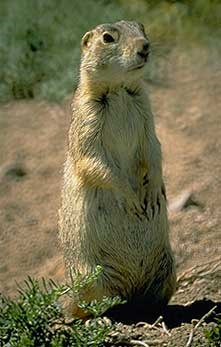|
Have you heard the prairie dog sound its alarm? As prolific plant eaters, master burrowers, and potential carriers of flea-borne plague, prairie dogs have a noticeable influence on their environment.

NPS Photo by Lisa Lynch PRAIRIE DOG COMMUNITY Gunnison’s prairie dogs emerge from hibernation around mid-March to late April. Each spring they produce a litter of three to four pups. The pups stay in their burrows four to five weeks before coming above ground. Usually by the end of June a prairie dog “town” is bustling with activity as hordes of youngsters make their debut in the open air. Burrow systems extend for 15 to 86 feet, with several chambers used as nurseries, latrines, resting areas and air pockets in the event of flooding. Crater-like mounds provide excellent observation posts. A maze of burrows aerates the hard packed soil while providing dens, protection from predators, and hibernation space for mice, rabbits, ground squirrels, snakes and insects. Prairie dogs are preyed upon by coyotes, hawks, eagles and badgers. In fact, prairie dogs make up 75% of the diet of golden eagle chicks. MYTH VS. REALITY At Curecanti, the Gunnison’s prairie dog has eaten away the annual grasses and shrubs for food and to more easily watch for eagles and coyotes. Shorter perennial grasses, shrubs and flowers with more nutrients now grow amongst the colony borrows. The benefits of prairie dog cultivation would be evident if this area received more moisture. PRAIRIE DOG MANAGEMENT Studies indicate that the plague usually appears when there is a stress in the prairie dog population. A major cause of stress is overpopulation. Most of the prairie dog’s natural predators have been reduced, and others, like the rattlesnake and black-footed ferret, do not exist at Curecanti. As prairie dog populations increase they are more susceptible to disease. In 1981, the entire colony at North Willow Creek on Blue Mesa Reservoir was killed by plague. In 2005, colonies at Elk Creek and Stevens Creek experienced a substantial die-off due to plague. When prairie dog colonies die, their predators, such as the golden eagle, must find other food sources or leave the area. Visitors camp near prairie dog colonies. Curecanti follows an active management program to assure visitor safety and to maintain a healthy prairie dog population. Prairie dog colonies are constantly monitored for the existence of plague-carrying fleas. Fleas are collected from prairie dogs and their burrows for analysis. Flea populations are reduced by dusting prairie dog burrows with insecticide. Encouraging growth of high vegetation and establishing raptor perches to increase predation by hawks and eagles helps control the population. On going scientific research will help determine the best management strategy so prairie dogs and people can co-exist here at Curecanti, and elsewhere throughout the West. |
Last updated: February 24, 2015
